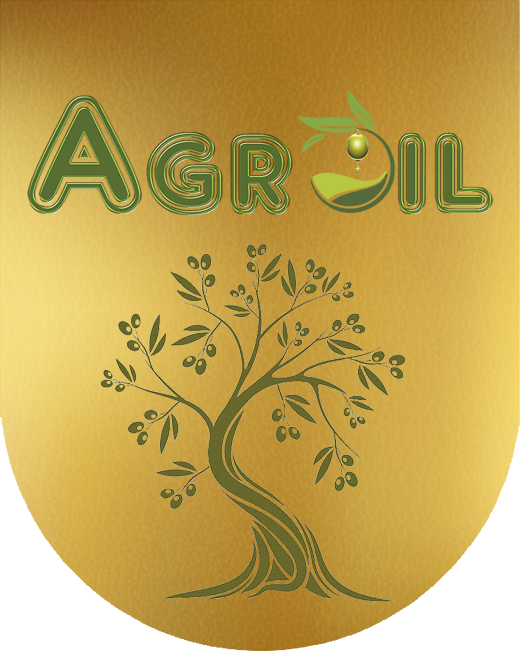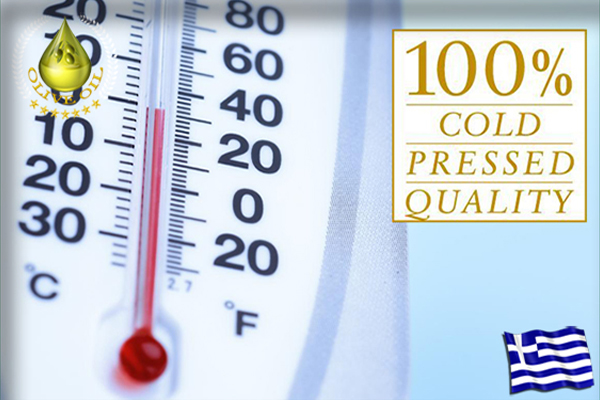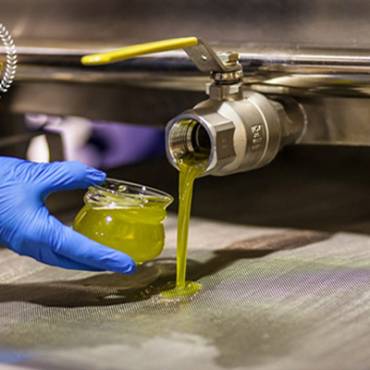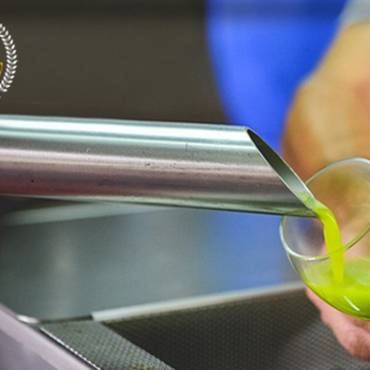Αναλυτικά:
COLD=WITHOUT TEMPERATURE PRESSING OUT/PRESSURE
The product’s processing must be made without the addition of any type of heating or the addition of warm water also. Any heating type procession, as mentioned before, that is exceeds the product’s physical temperature it is not an unheated process and cannot be named as such, for example, if the product has a self temperature of 10c degrees Celsius and we increase that status to 15 degrees, that process is named anything but unheated olive-oil. But if our product for instance has a temperature of 10 degrees Celsius and we do not increase that status or we decrease the temperature to 5c degrees this actually constitutes the unheated/cold pressed olive-oil.
Unheated/ cold pressure.
We make the separation between olive oil and olive fruit core with vertical centrifugal system at 1.300 spins. ( See here )
Result:
In order to achieve unheated pressing of any product, its juice extraction must take place using few spins and without any water addition or outer temperature higher than its own.
And now lets examine the olive crop.
Olive crop after the leaf stemming and washing, is lead to the scutching machine (and now the hard part begins).
1) Olive’s segmentation through :
a)Hammer mill: The high spinning which scutching machines can achieve (3.000 and more spins) leads to the appearance of emulsion in olive-oil (a deterioration of the product). Up to 1.400 spins it has been ascertained that the damage of olive oil is minimal. However, to achieve the perfect grinding means that olive segmentation must take place with under 1.000 spins.
b)Millstones: They produce many fungi.
c)Olive’s segmentation in our olive mill: ( See here )
2) Mollification of olive paste, masticators :
a) Leverage in open masticators and/or the addition of heated water as the majority of manufactures use in order to soften and decreasing the lubrication status of dough. For example if pulp with a blender a handful of green olives and then spread them in a plate and two minutes after with a small tablespoon take a part of paste and turn it over , you will see the side beneath that is still green but the upper one turned to brown color, which means that it is oxidized. Imagine what will happen in an open type masticators where the mollification lasts 30’-40’-50’ or even an hour into the heat?
b) Mollification in our olive mill: ( See here )
3) Separation of liquid and solid matters:
a) Decanter centrifugation (3.000 -4.000 and over spins). To separate the core, oil and waste, hot water adding and excessive spinning results in a criminally combination which washes off and depletes all the nutritional polyphenols,( polyphenols are soluble in water ), and that has as a result not only altering the product but the actual destruction of the olive-oil.
b) Extracting with small special tools (groupers). After the mollification the dough is spread on the special tools and then it is led to the pressing machine where the dough will be pressed mechanically or hydraulically, in order to expel the liquids, the olive oil with the waste. This process is actually better than multi-spin centrifugation, but helps a lot of fungi to grow. Of course it is during this phase that the disastrous process of using hot water is all too common.
c) Cold pressing out in our own olive mill: ( See here )
4). Olive oil cleansing:
a) Centrifugal separator, pomace extractor hyper multi-spin 7.000 spins + (which is mandatory to use after the decanter process) and a second type separator hyper multi-spin 8.000 spins + (which is used by the majority of oil-presses, furthermore at the last stage, olive-oil cleansing from any residues, here comes again the cooperation of spins and warm water ( polyphenolsare soluble to water ), which contribute to what we consider a crime against olive-oil. If any polyphenols had survived from Scylla’s and Charybdi’s teeth, (the multi –pins decanter), they will be washed off at this point. The separator works as a shaker too and it will give us an optically rich creamy and delicious, to look at, olive oil, however this appearance, of course, does not last for long ( an hour or a few hours ) and the olive-oil which we will get is just a fatty substance, and not olive-oil.
c)Separation in our own olive mill: ( See here )
The rising of many questions about the processing.
“Unheated pressure of the fruit” and why everyone do not use the unheated way for the extraction of olive oil?
-High quality olive oil is produced solely under specific conditions and from people who have the necessary specialist knowledge about the product.
Here are some important things to know:
The correct timing of picking the fruit is very important for making high quality olive oil.
We ought to: select the best, not too overripe olives.
Unripe olives produce a particularly high quality of green olive oil, but in a smaller quantity, on the other hand the ripe olives produce a bigger quantity of olive oil but with higher acidity and thus lower quality.
We ought to: collect the fruit with our hands as to not to damage it.
We ought to: bring fruits to the olive mill and begin extracting the same day as the picking takes place.
We ought to: remove leaves and branches from the fruits and then in turn to wash with clear cold water.
We ought to: mash it through a scotching machine up to a max 1.000 spins.
It should: have the masticators being of a classic type (waterproof) in order to avoid the oxidation of the fruit.
We ought to: process the fruit with as fewer spins as possible without heating, and without the use of several chemical solvents.
Olive oil should: remain unfiltered, since filtration removes many nutritional properties.
With few spins and without heating is produced the wild olive oil or olive oil which called “extra virgin with cold pressing out “.
Through the method of cold pressing out, the given result is the production of a higher quality product, since its purity have not been affected from heating or chemical substances. However, the high rate cost consists the main reason due to this procession of extraction is not chosen by the majority of oil producers, olive manufacturers and olive oil merchants due to the fact that of no temperature pressing procession the amount of olive oil is reduced. So there ia tendency to reduce the cost of production in time and money. That’s why the production becomes automated and the product procession is done massively in big hi-tech facilities in the aim of quantity and the low cost and not high quality.Modern industries indeed produce great amount of olive-oil in a low price, but at the same time the procedures which are followed reduce in a remarkable big percentage the nutritional value of olive-oil.
What does reduced cost mean in the case of olive-oil ?
Reduced cost means that olives are probably grinded with other impurities ( leaves, branches, e.t.c.).
Olives which have fallen on the ground, produce lower quality olive oil, and usually are mixed with good fruit.
Olives are saved in tanks of different kinds, without properly conditions.
They are accumulated in huge piles, where they are left for days or even weeks and they develop fungi mash and bacteria, and as a consequence the resulting olive oil is crucially downgraded.
During centrifugation, water of high temperature is added in order to separate olive oil. polyphenolsare soluble to water. Thus, they are washed off and removed, during the procedure.
Apart from the reduction of the nutritional value, the lack of the antioxidant action of Polyphenols also means the reduced life expectancy of the product.
Moreover, elaborated olive oil is filtered in order to be clear and to look crystal clear.
Nutritional value of extra virgin cold pressing out olive oil.
Cold pressing out olive-oil is distinquishable from its scent, its colour and its flavour. Its acidity is especially low, always below 0,3%.
It is rich in sterols (mainly b-sitosterol) , and in fatty acids, mainly oleic acid (omega-9), linolenic acid (omega-3), and linoleic acid (omega-6).
Characteristic is the conciseness of antioxidant substances, such as, tocopherols (vitamin E), vitamin c, carotenoids ( b-carotene, xanthophyll ) phenols and polyphenols..
The “trap” of extra virgin cold pressing out olive oil…
In real terms, the product which many manufacturers claim to be of cold pressing out and extra virgin olive oil has nothing to do with the one that was consumed by our ancestors.
The majority of this kind of olive oil indeed concerns products of lower quality which has been elaborated in order for its acidity to be reduced at 1% , 2%, 3% until 8%,so it misleads the consumers by being called “extra virgin olive oil” on their label.
HOW TO GET OUR PRODUCTS
UNHEATED WILD OLIVE-OIL UNHEATED GREEN OLIVE-OIL UNHEATED OLIVE OIL
*The words or phrases in blue colour work as buttons, press on them and they relocate you to the explanation of the word or phrase.




1 Comment
Καταπληκτικοί…….